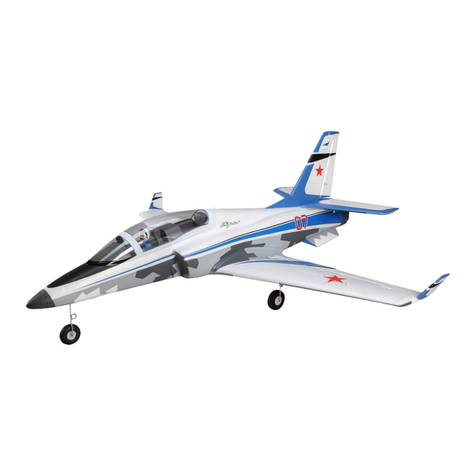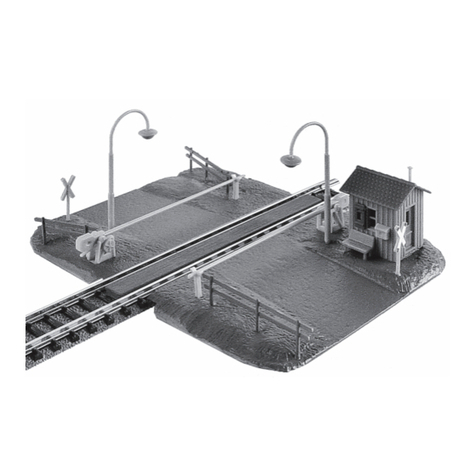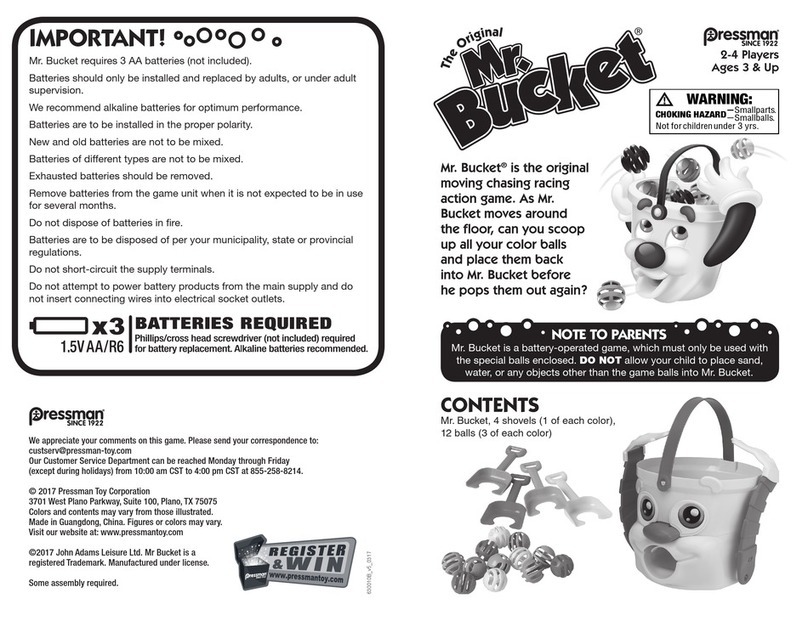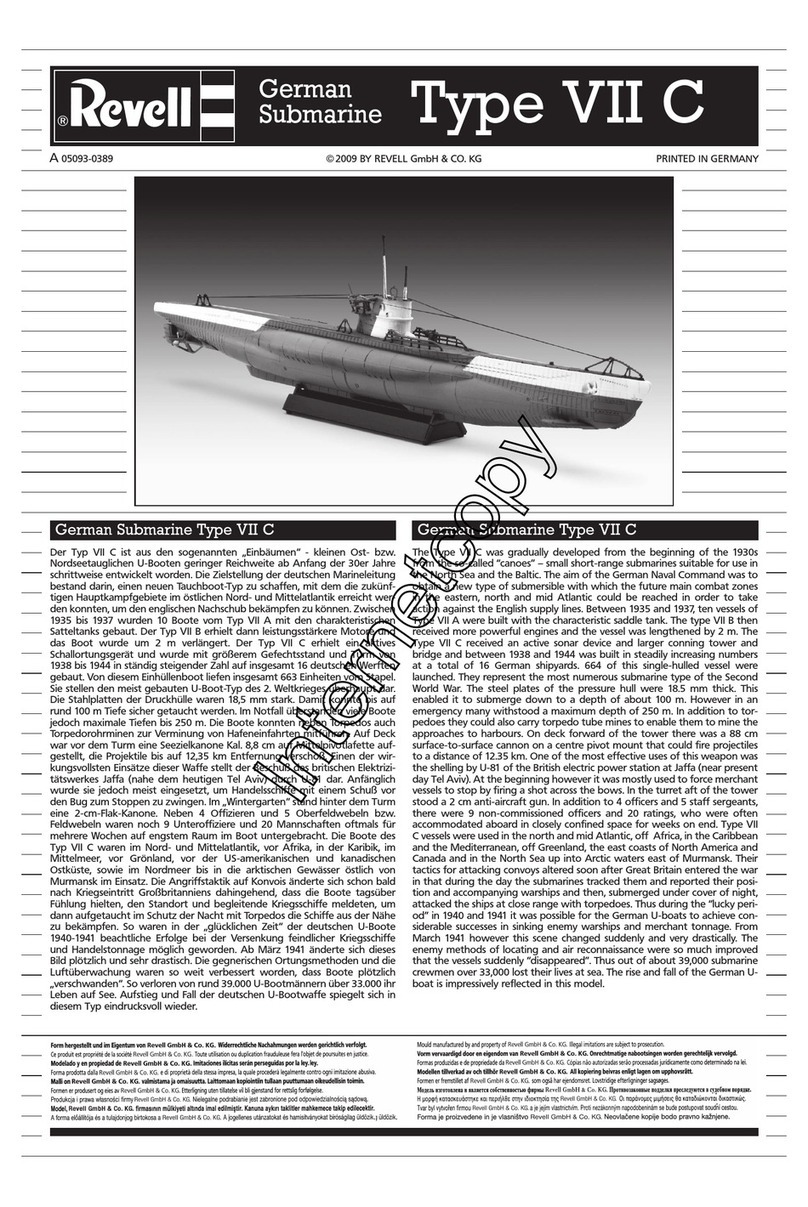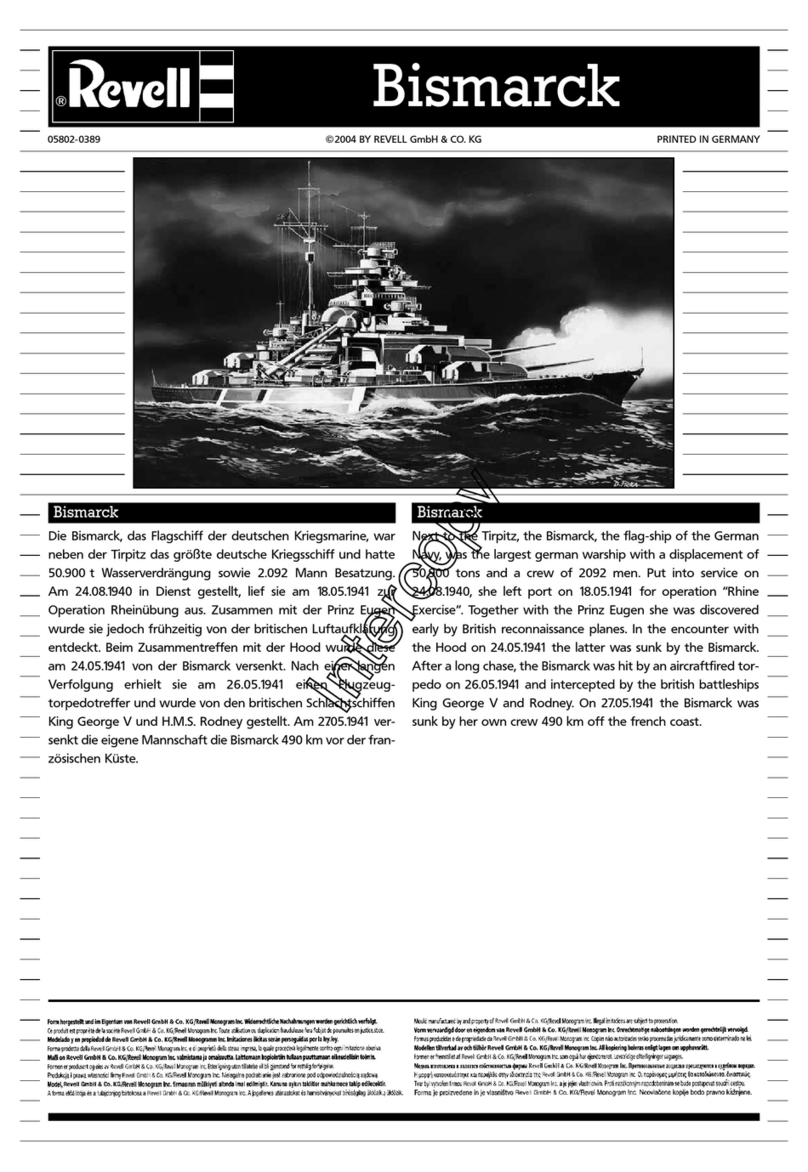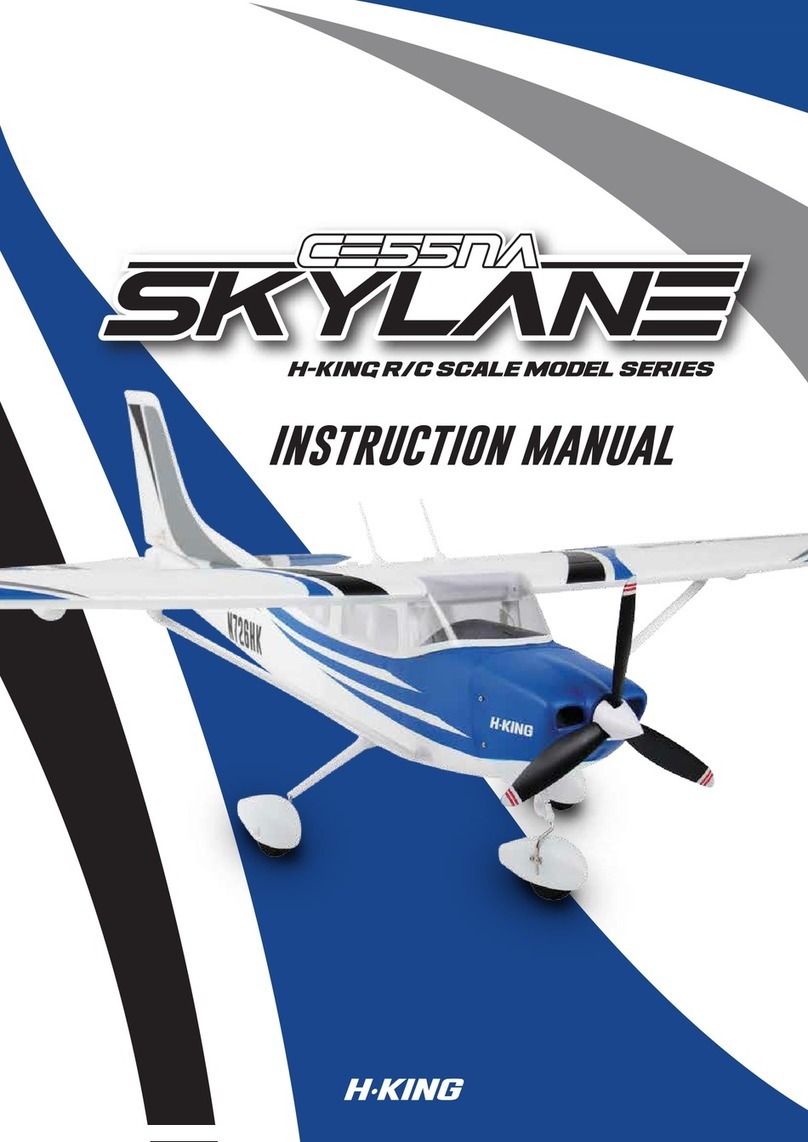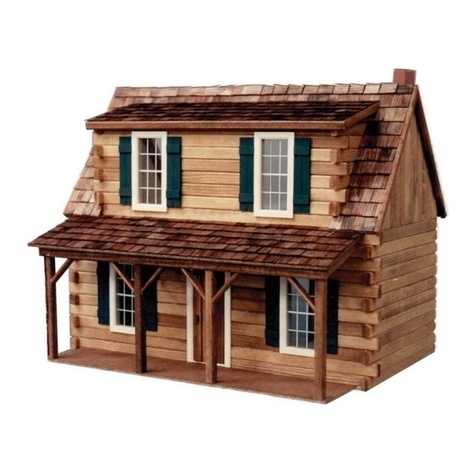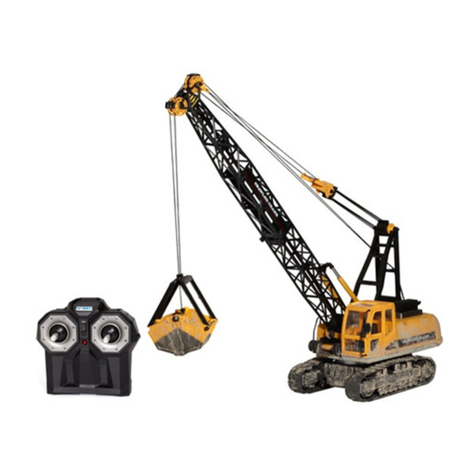Der Jet Model DerJet F-35 Lighting User manual

INSTRUCTION MANUAL
Specication
Wingspan.................................. 1,340mm
Length......................................... 1,960mm
Scale............................................. 1:8
Equipment required
Turbine: .......................100-120N
Radio: ...........................Minimum 9 channel radio system.
Servos:.........................Elevators - 2 x 20Kg+ servos
..........................................Ailerons - 2 x 10Kg
..........................................Rudders - 2 x 4Kg+ midi servos
..........................................Nosewheel steering - 1 standard size servo.
Valves: .........................3 x Dual action electronic valves (Jet Tronic)
..........................................1x Brake valve.
Gyro:..............................3 Axis gyro system (Powerbox iGyro3e)
General: ......................Various adhesives, radio extension leads, fuel
accessories, scale pilot.
Der Jet Model
No. 178-1, Sec. 2, Nantun Rd., Nantun Dist.,
Taichung City 408, Taiwan.
www.derjetmodel.com

WARNING
This F-35A model is not suitable for aeromodellers without experience in building,
operating and ying technically complicated airframes. Success requires care
and consideration. Assembling this ying model requires the builder and persons
operating it to understand DerJet Model have no control on how it is assembled
and the equipment chosen is installed. For this reason it cannot accept loss or
liability brought about from incorrect assembly or incompetence in operation of the
kit and the companies’ total liability cannot be greater than the amount paid for this
model. This applies to personal injury, death, damage to buildings or property, loss
of turnover, interruption of business and any other direct or indirect consequential
damages.
By operating this model aeroplane you assume full responsibility for your actions.
Operating any jet turbine powered model aeroplane requires the persons to
understand the risks involved and they should check with the relevant authority in
the country the aircraft will be operated in. In the USA this is the AMA, UK BMFA,
Germany DMFV, it is your responsibility to nd the relevant authority where you will
operate the F-35 model.
The persons should understand the danger zones particularly behind and in front
of the aircraft and keep people or animals clear. A suitable re extinguisher should
always be manned and before any ight the safety systems should be checked in
accordance to the relevant manufactures instructions.
INTRODUCTION
Thank you for choosing the DerJet
F-35A model of one the World’s latest
multirole, all weather ghters. The full
scale was developed in conjunction
with several prominent companies who
supplied power units and electronic
equipment to the Lockheed designed
airframe. The full scale airframe features
a lot of composite materials in its
construction, much like our 1/8th scale
model!
Being of single engine design, it is a
perfect subject to model, the lifting
design fuselage produces a lightly
loaded airframe in the air and simple all
moving horizontal tail control surfaces
and large twin vertical ns oer fabulous
control authority and ight stability.
DerJet’s attention to detail keeps the airframe weight low, making it possible
to power this near 2m long aircraft with a 100N turbine. Turbines in the 100 to
120N class are recommended. Fitting a larger turbine is neither necessary nor
recommended. The instruction manual airframe has a JetCat P-90Rxi (105N thrust)
DerJet have replicated the undercarriage and gear door layout, the
main gear twists into position, the mechanism making it very dicult to
use rams to close the rear doors. Small springs are provided for these,
with air rams closing the cycled front main door section. The twin nose
doors are also closed using two air cylinders provided. No valves are
provided as there are several options open to the builder, individual
servo operated valves, individual electronic valves, all in one UP valves
or the EV-5 valve. Two valves are required for the doors as the nose
doors stay open and the front main doors cycle, being closed when
the gear is in the up and down position.
NB It is important that all the door pairs are set at the same angle. The
large area and near vertical open position, mean that they can easily
act as turning vanes or rudders if they are not matched.

The F-35A is a great modelling
platform as the undercarriage
stays in the fuselage making
transport easy.
NB: The valve used on the
undercarriage must hold
pressure on the rams to keep the
gear locked down in transport.
Assembly at the eld is also easy
with a single servo plug and
screw to x on each wing. The
design allows internal linkages
throughout, no ugly control
horns protruding from any of the
surfaces.
BEFORE YOU BEGIN
Every eort is made to pack the airframe carefully for the journey from the factory to
your workshop. Please inspect all parts of the aircraft before commencing assembly. The
airframe has been assembled in the factory to ensure a good t.
Although every care has been taken to assemble the undercarriage parts correctly,
please check each part for security, before commencing the build. Axles will require
xing with locking uid.
Note: The twist and turn main units need carefully checking for smooth operation. There
are several processes that need to happen for reliable operation. The locking cylinders
need to have air pressure applied when the gear is down to keep the main gear locked.
When the gear operates the locking cylinders need to operate ahead of the main leg
cylinder for retraction. This can be achieved with dierent lengths of airline, or additional
valves that are timed dierently.
It is critical the gear works reliably, the lifting fuselage does not respond well to airow
interruptions created by stuck legs or open doors. Before each ying session we
recommend you cycle the gear before ying. Reliable operation on the instruction
manual airframe is achieved at 110psi. The gear retracts forward, so travelling at a high
airspeed when you start the retraction sequence will slow down the retraction and could
restrict it completely. When the main front doors open there is a reduction in lift, since
there is a large hole in the lifting section! A good technique is to retract the gear while
ying straight and level, slow the speed and then cycle the gear. Once clear, you can
accelerate into a normal ying routine.
The F-35 is not for inexperienced pilots.
ASSEMBLY
Use good quality epoxy glue for any joints. Hysol 9462 is perfect.
All hardware is metric, so a set of high quality metric Allen keys will be required.
Assembling the two fuselage parts is easier with a long 3mm Ball end driver. The Bondus
Pro Hold type or some form of magnication will help to hold the screw on the tool until
tightened.
The split fuselage makes access easy until the two halves are joined. Several steps are
required before joining. The fuel tanks are easier to position before joining the two halves,
the fuel system needs to be plumbed and tested as access is restricted once the two
halves of the fuselage are joined. Mounting positions of any ancillary items should be
considered to allow access to the screws with a ball ended 3mm driver.
Access to the outer fuselage joint xing screws is via the gear door openings, the centre
screws are accessible with the turbine removed.

WINGS
The wings are relatively simple, as
they have a single control surface
and there are no air systems in the
wing panels. A single servo with a
torque of at least 10kg is required.
Because of the wing fairing shape,
a servo with a maximum depth
below the mounting lugs of 27mm
is required.
Fit a 16mm arm and
mount the aileron
servo with the servo
spline towards the
leading edge. A
hole must be drilled
(minimum 10mm) to
allow the servos lead
to be routed through the servo mounting plate.
Mark the aileron control horn position with some masking tape, a slot needs
cutting in the face of the aileron to take the control horns. The control horn should
be installed as close to the lower skin as possible (furthest away from the hinge
line). Some shaping of the control horn maybe required to match the curved
surface of the aileron.
Because the aileron hinge line is not at 90 degrees to the control linkage a ball
link must be used at the control surface end. Use an M3 forked spring steel clevis
at the servo end. The wings are held in position with screws accessed through
the rear gear door openings, from below. These are screwed into the wing spar,
through the wooden blocks.
FINS
The ns mount on two aluminium pegs that are tapped M3 in the
end. Fixing screw holes are accessed by removing the elevator servo
cover plates and xing the two screws. Ensure you use the two large
washers provided. It is good policy to use a small amount of loctite or
UHU por glue on the threads to ensure they never work out.
(NB-if you use loctite, a spot no larger than the diameter of the screw
is required)
Rudder servos should be 4.5kg
minimum, metal geared servos are
recommended. It is imperative the
rudders are slop free.
The rudders are centrally hinged with
hinge point type hinges. Epoxy these
into the rudder rst, before mixing
any glue, ensure the hinge holes are
central on the surface thickness. The
hinge pins must be in line with the wire
control rod pivot inserted in the base of
the rudder. The steering arm is metal
and a slop free linkage is required to
resist utter on the angled ns.
Temporarily t the rudder servos to
establish the line your rudder pushrod
will take. Some trimming of the wooden
former may be required for a clear path.

Cut down the supplied brass steering arm so that it ts in the space, match the
servo arm centres to the steering arm hole centres. The F-35 rudders are quite
powerful, so 6-8mm movement each way is sucient. A ball link is required on
the brass rudder horn steering arm, because of the angles. A clevis is used on the
servo arm at 11-12mm radius. The spacer sleeve needs supporting to
guarantee a solid, slop free linkage.
ELEVATOR/FLYING TAILPLANE HALVES
The F-35 is unusual in that the elevators are hinged o the rear face of
the fuselage. The hinges are factory tted along with the control horns.
The elevators pivot on two 3mm pins. Ensure the hinge is free before
connecting the servo and linkage, the large elevators will produce
large trim changes if they do not return to neutral exactly each time.
For this reason high quality servos with known centring should be
used. We used JR 8711 and JR 8911 servos in the prototype models.
Remove the two cover plates located in the rear lower fuselage and
mount two metal geared 20kg+ servos on the brackets provided.
Connect the servo to the surface with the M3 pushrods and ball links
provided. The servos should be tted with metal control arms - nylon
arms are not suitable. Keep the servo arm radius as short as possible.
20-22mm is sucient to get full travel.
The large area elevators give powerful control inputs-check that the
linkages move freely, any friction must be removed for smooth ight.
Elevator neutral is with the leading edge point just above (1.0mm) the
fuselage side datum edge.
UNDERCARRIAGE
Before starting the undercarriage t out,
remove the wheels and brake units. After
checking each part re-assemble with a small
amount of grease on the O rings and brake
surface. This will provide a perfect seal and
reduce brake snatching.
The wheel axle should have a small at added
where the xing grub screw seats. Ensure the
wheel axles are greased before assembly. The
F-35 has a high ground speed, so the wheel
bushes need to be regularly lubricated. Use
a small amount of blue loctite on the M4 set
screw that retains the
axle.
When installing
the nose unit, use
plywood packing
pieces under it
as shown right to
increase the model’s
angle of attack.
The main leg cylinder
swivels as the gear retracts, lubricate the swivel to ensure a smooth operation.
The nose unit should be inspected before installation, screws checked and xed
with loctite. The pivot boss should be lubricated with grease before installation
in the unit-ensure the clamping screw is tightened suciently to retain the boss -
but not so tight that the leg will not turn! The nose wheel bushes need lubricating
with grease or Teon oil.

Undercarriage operation
Some care and thought is required when routing the airlines from the main
legs and units. Operate the legs multiple times so that you can understand the
path taken by the various air connections. Some will twist and move quite some
distance during the retraction process, so allowance in the tubing
free lengths will be critical. There are various trap points that occur,
particularly with the lock ram assembly. Reliable operation requires
equal tube lengths either side of the airframe. Each airline should be
routed to ensure no chance of kinked lines.
NOTE! The small locking cylinder must operate before the main
cylinder, when the gear retracts. This breaks the straight locking link,
so that the main cylinder can pull the leg up. We achieve this with
a split retracting (up) airline of unequal length. Keep the retraction
airlines coming from the valve as short as possible before a T or
Y piece splitting it. Make the line going to the main large cylinder
retraction nipple side 300-350mm longer than the line going to
the small locking cylinder. This will make the small locking cylinder
operate before the lift cylinder. The extension phase can have equal
length lines to the main cylinder base and lock cylinder extension side.
The air system valves can either be mounted inverted on the fuselage
top surface, between the fuselage break and the cockpit opening.
Mounting the valves on a plate that is Velcroed to the fuselage allows
it to be easily removed for access. Alternatively there is space on either
side of the cockpit opening.
The air tanks can be
mounted in the rear
fuselage section,
above the fuel tanks,
centred on the
fuselage. We mount
the air ller valves on
one side of the turbine
access hatch.
The F-35 gear doors are all angled slightly in the airow. This makes cylinder
force critical for resisting blowback. The main door (front doors) cylinders are
horizontally mounted to the main former, ensure the line of leverage gives the
maximum possible in each direction.
The nose cylinders
are mounted vertically
to the fuselage side,
small notches in the
radio tray may be
required for clearance.
The rear doors are
mechanically operated
by the main legs.
Springs are provided
and these can be xed
to the leg, or wrapped
around the leg, so that
the retracting leg pulls
the door closed.
Small cams maybe
required to keep the
door clear of the leg
during the initial retraction phase. We made these of 2mm thick scrap plywood
glued to the bottom edge of the door.

UNDERCARRIAGE
& GEAR DOOR
DETAILS
A selection of four
images that detail
the layout of the pipe
work to the main gear,
brakes and doors.
Use these to plan your
installation.
CANOPY &
COCKPIT
There is very little clearance under the cockpit tub base, you can gauge the space
available before you join the fuselage halves-shine a torch forward from the
fuselage split. Most of the equipment can be mounted behind, or to one side of
the cockpit opening.
To achieve the required balance without additional weight we used a 5000mAh
2 s Li-Po for the Turbine ECU and 2 x 2200 2s Li-Po supplying a Powerbox Sensor
switch, all three batteries are mounted in the nose area. The receiver and gyro are
mounted on the rear radio plate, just under the canopy opening. A small Powerbox
unit like the Mercury
would be an excellent
solution, since it
includes the 3 axis
gyro and sequencing
required for the gear
doors.
Note the fuselage
shape and cockpit
opening gives the
impression that the
radio plate is not level
with the datum, it is.
This can be veried by
using a small bubble
gauge level. Mount the
gyro on the back edge
of the radio tray over
the rear former, which
provides an ideal stable
mounting surface.
Any cables should
be clipped to the
fuselage sides to avoid
any chance of them
becoming tangled
in the nose retract
mechanics. The nose
steering servo passes
through the elongated
hexagon opening in the
radio tray.

FUEL TANKS
Each fuel tank is approximately 1.9 litres. These should be connected in parallel
via a T piece to the supplied hopper tank. The main tanks sit on two at plywood
plates, located just behind the fuselage split. They should be retained
by Velcro straps. We recommend you place some Velcro under the
tanks to ensure they do not slide around.
Before assembling the tanks ensure they are completely clean and
free from debris. Clean the sharp edge from around the opening, then
ush with alcohol cleaner
(water will take a very
long time to evaporate)
and place in a clean
environment while you
assemble the tank ttings.
Weighted clunks are
supplied, but an absorbent
type clunk (felt clunk) can
be substituted to ensure
continuous fuel
supply to the hopper
tank. Use a clunk line
suitable for immersion
in kerosene. We used
Tygon 4040 tube with
a 3.2mm bore and a
high ow felt clunk
(minimum internal hole
2.7mm)
Pressure check the tanks before installation, as access to the ttings
requires splitting the fuselage joint.
Before nal positioning of the fuel tanks, retract the main
undercarriage legs as the main wheels will contact the tanks if
positioned too far out. We placed Velcro on the mounting plate and
fuel tank base and then added a Velcro strap around the tank. This is
accessible through the main gear door openings.
The tanks should be mounted as far back on the plate as possible.
Note: It is important to keep both fuel lines from the tanks equal in
length, so they ll and empty as equally as possible. Thought should
be given to the position of the overow vent in the fuselage lower
surface. The sculptured shape allows an overow tting to be tted
close to the centre of the fuselage and still be clear of the ground in
the event of a gear up landing.
The kit includes a hopper tank, mount this or your favoured type
towards the back of the canopy opening. Use large bore tube
throughout the fuel system.
TAIL PIPE TUBE
The supplied tailpipe is suitable for use on turbines from 100-120N
thrust. It is a dual wall unit to keep fuselage temperatures down.
The rear is supported by the supplied cut away wooden ring, the cut
outs allow some airow through this area. This is screwed to the tail
cone former. The tail pipe outer wall is not xed to the former as it
must be free to expand and contract with temperature.

The tail pipe mounting straps at the front should be screwed to the
turbine mounting rails, or folded 90 degrees and xed to the former.
The turbine to tube gap should be provided by your chosen brand of
turbine, but 25-30mm is common. This is turbine tailcone back edge, to
the start of the steel tailpipe tube.
The bre glass tailcone assembly is screwed to the rear fuselage
former, there is space around the tailpipe tube to access the screws
using a long screwdriver.
The overall length of pipe supplied suits
smaller short turbines like the JetCat
P-100Rx. If you use a larger longer turbine
the pipe can be reduced in length to suit.
Use protective gloves and glasses before
cutting metal with any tools.
The tailpipe should nish with the outer
tube (cool wall) ush with the tail cone
back edges. The inner pipe must be
8-10mm short of the outer pipe to draw
air through the tailpipe
tube and cool it.
Final centring of the
turbine in the tail pipe
tube is critical for even
heat on the pipe wall.
Mount the turbine on
the wooden rails rst
and use the tail pipe
straps to adjust the
tailpipe height.
FINAL ASSEMBLY
Balance Point
Balance position 30mm in front of the turbine hatch lip, with the hopper full and
approximately 25% fuel in main tanks.
Control Throws
Control movements are measured elevator leading edge point. Ailerons at the tip,
rudder at the base.
Elevator neutral is the leading edge point 1.0mm above the side fuselage ridge
(slightest down elevator).
Settings of control movements
Normal ight condition:
Aileron: 14 mm each way, using 35% expo
Elevator: 55 mm up/30 mm down, using 40% expo
Rudder: 6-8 mm each way 0-15% expo
Take o ap: 8-10mm, with no elevator compensation.*

Low:
Aileron: 10 mm each way, using 25% expo
Elevator: 50 mm up/30 mm down, using 35-40% expo
Rudder: 6 mm each way 0-15% expo
We recommend tting a 3 axis gyro like the Powerbox iGyro 3e. To get the best
from this unit set the internal gyro gains with elevator and rudder at 80%, leave
the ailerons at 100%. If using a switched gain channel set the gain at 35% which
is safely below the setting we achieved of 40-45% Using the iGyro 3e the F-35
ies best in the heading hold position. Using a knob or slider you can set 35%
either side of neutral , so one way is rate mode and the opposite is heading hold.
Landings are best when ying in heading hold as the F-35 wants to land nose high
and the HH setting will naturally maintain this.
Before ying the F-35 it is critical the gear and gear doors work reliably. The door
angles are such that if one does not open a large yaw angle is likely to occur. The
lifting fuselage design becomes less ecient when the doors are open! Cycling
the gear before each ying session is strongly recommended.
FLYING
The F-35 is a modern design, where the full scale
aircraft is made super manoeuvrable using an
‘unstable’ balance point and computer control.
This is like a super gyro, which even the best
model gyro cannot replicate.
The model balance point is well forward of the full
scale position, this makes the model F-35 stable in
pitch, but means the balance is well forward of the
main wheel/rotation point. As a result the model
F-35 requires a reasonably long take o run at
higher than normal ground speeds to provide the
elevators enough leverage for rotation. We would
not recommend operating the F-35 from strips
shorter than 180m (540’)
We recommend test ying the F-35 on a calm day,
with smooth air as this will aid trimming and gyro
set up. Set your Tx timer for 7 ½-8 minutes, which
is a safe ight time for the test phase.
Takeo is best performed with the ailerons
drooped 6-7mm (at tip) to increase lift, holding at
least 50% of the available up elevator throughout
the take o roll, you can sense the nose wheel
starting to skip/lift and at this point pull for a
normal rotation. Immediately after take-o clear
the ap and y a steady circuit gear down - Flight
characteristics of the F-35 are markedly dierent
clean or dirty due to the lifting fuselage design
being aected when the gear doors are open. It is
best to retract the gear while ying straight and level at a reduced airspeed. Trim
the aeroplane in the dirty stage (gear down, but main doors closed) y another
circuit and clear the gear away ying past into wind, this allows you to observe the
gear goes cleanly.
Keep in mind the gear legs all retract forward into the airow, excess airspeed
will slow the cycle speed. Once the F-35 is clean, any further trimming should
be performed. The instruction manual airframe with JR servos ies well with the
Powerbox iGyro 3e set at 40% gain.
The F-35 ies typical multiple roll ghter manoeuvres very well, it looks especially
good in high G turns, but note the huge drag and requirement to add power with
applied G.

Landing is performed with the ailerons level. The airframe has plenty of drag
‘dirty’, so landing speeds are very low, with throttle being the primary height
control once the nose is pulled up on approach. Because of the airframe design
requiring a high alpha approach, landing with the iGyro in Heading hold mode
helps maintain the nose high sit.
The F-35 should be ‘own’ onto the ground, the lifting section fuselage requires
a positive angle of attack to produce lift. Throttle use is important for smooth
touchdowns, use power to bring the F-35 to the point of touchdown, always main
wheels rst. The wheel position means the nose quickly comes down, so landings
are very unlikely to bounce.
We hope you enjoy your F-35A model, if you have any questions regarding the
build or operation feel free to contact us at in[email protected]
This manual suits for next models
1
Table of contents
Other Der Jet Model Toy manuals
Popular Toy manuals by other brands
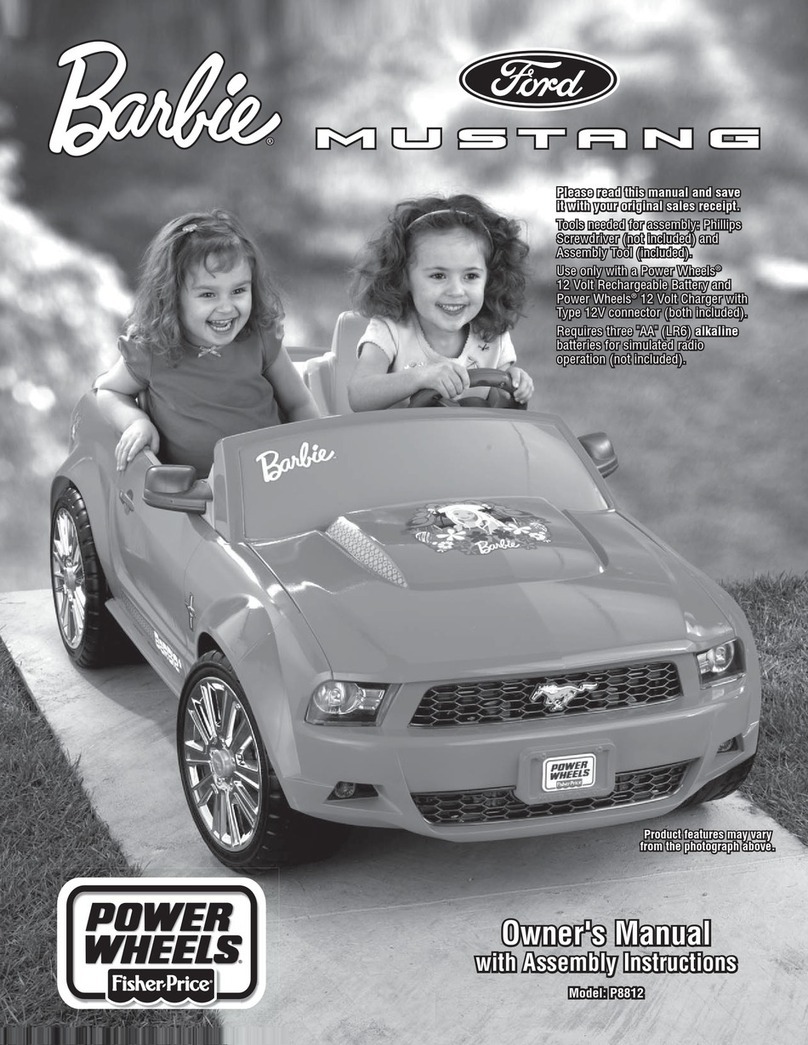
Fisher-Price
Fisher-Price POWER WHEELS P8812 Owner's manual & assembly instructions
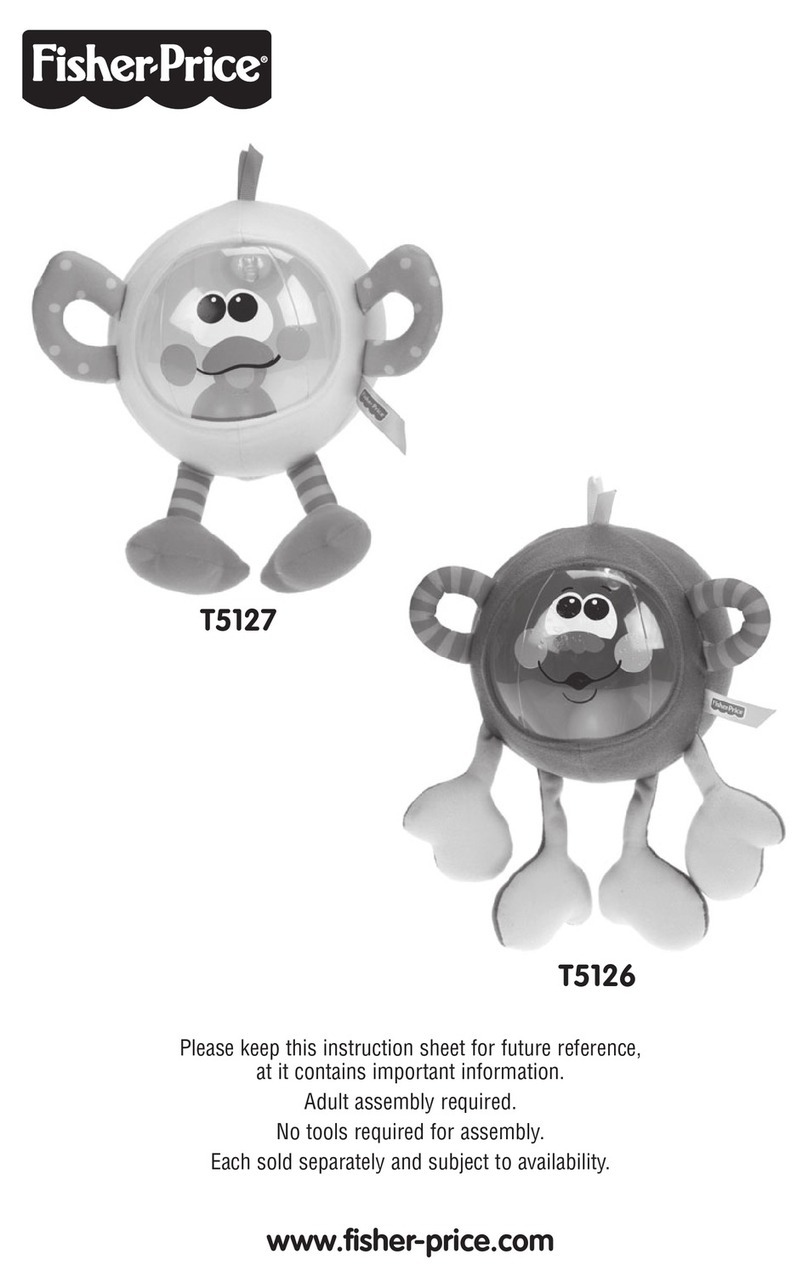
Fisher-Price
Fisher-Price T5126 instruction sheet
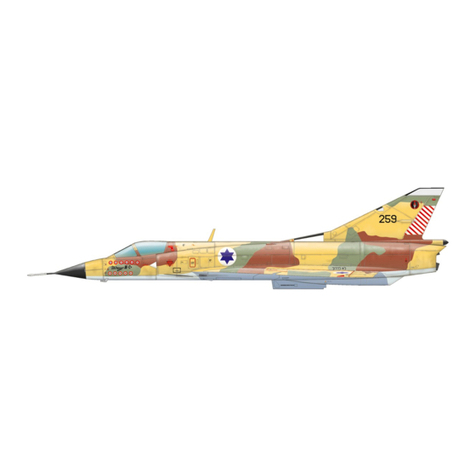
Eduard
Eduard Weekend Edition Mirage IIICJ Assembly instructions
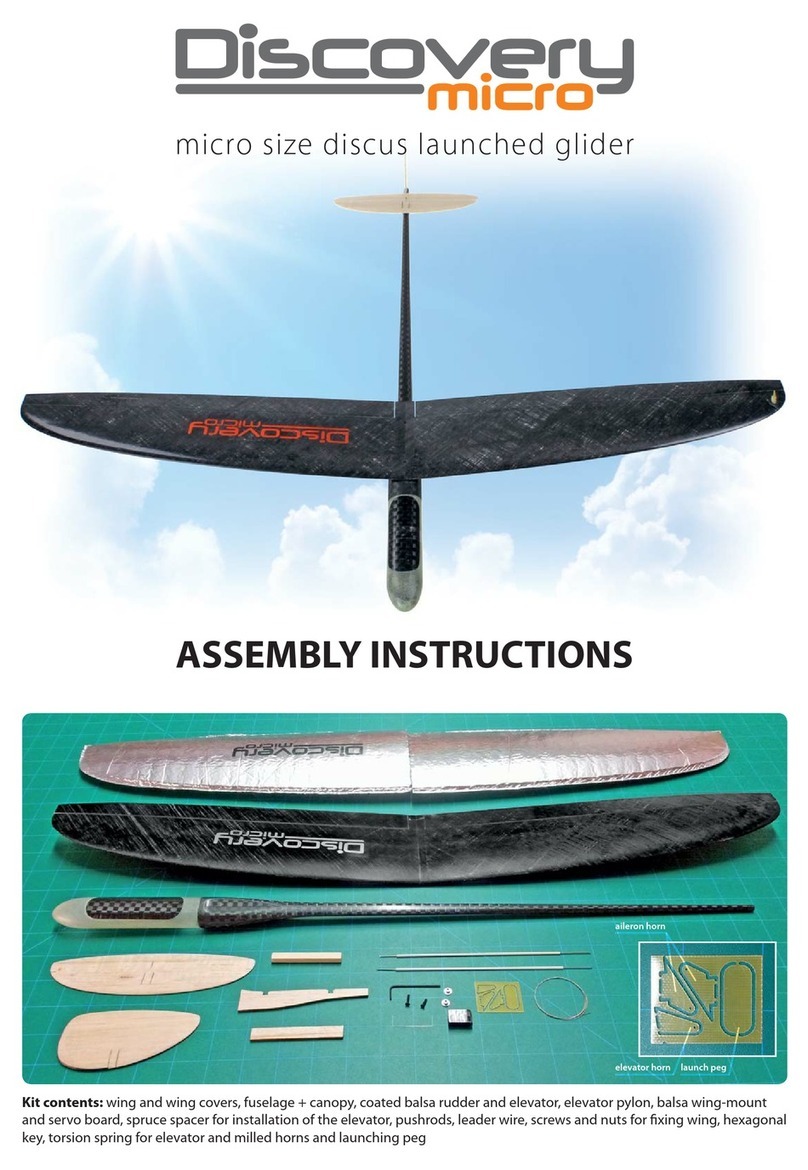
m2model
m2model Discovery micro Assembly instructions

Hasbro
Hasbro Transformers Toys Generations War for Cybertron: Earthrise Voyager WFC-E21 Decepticon Snapdragon Triple... manual

Betzold
Betzold 760491 instructions

